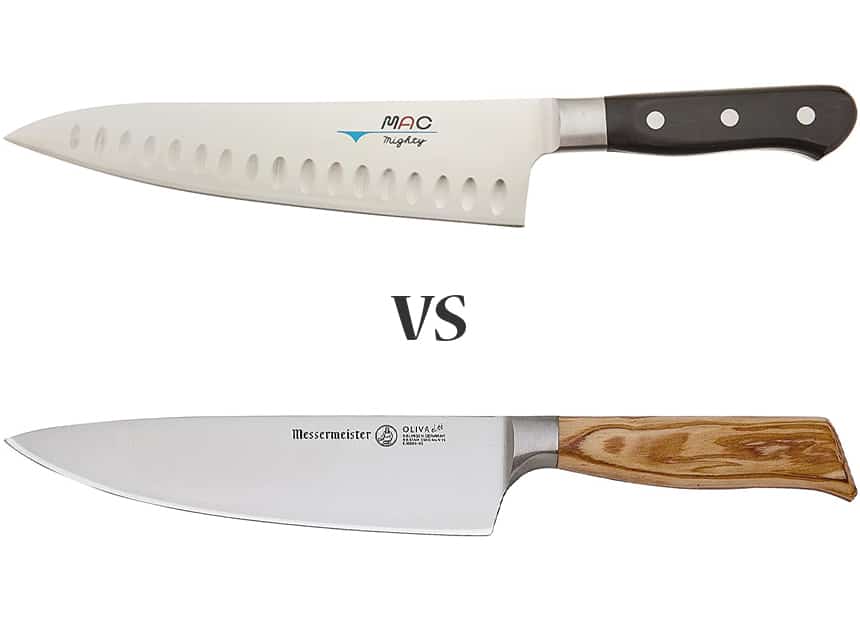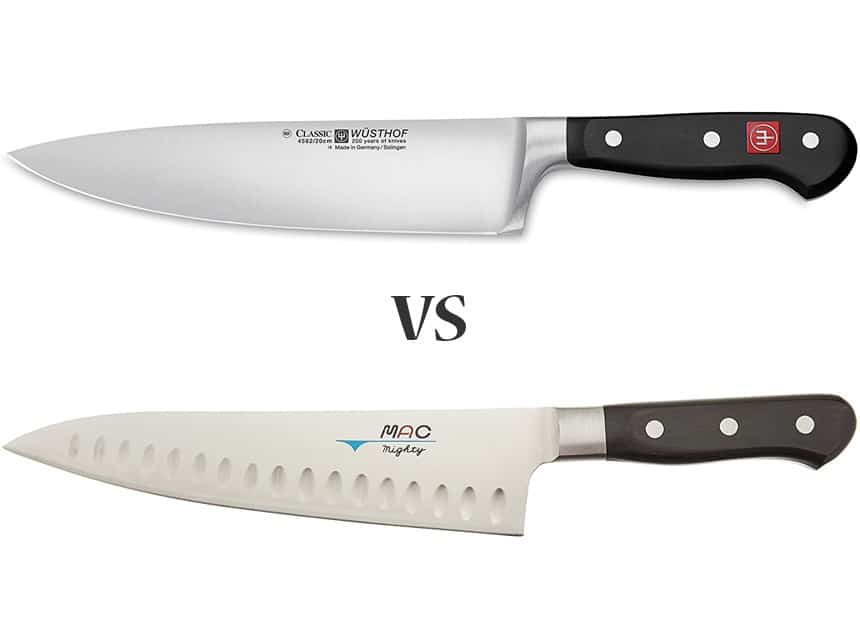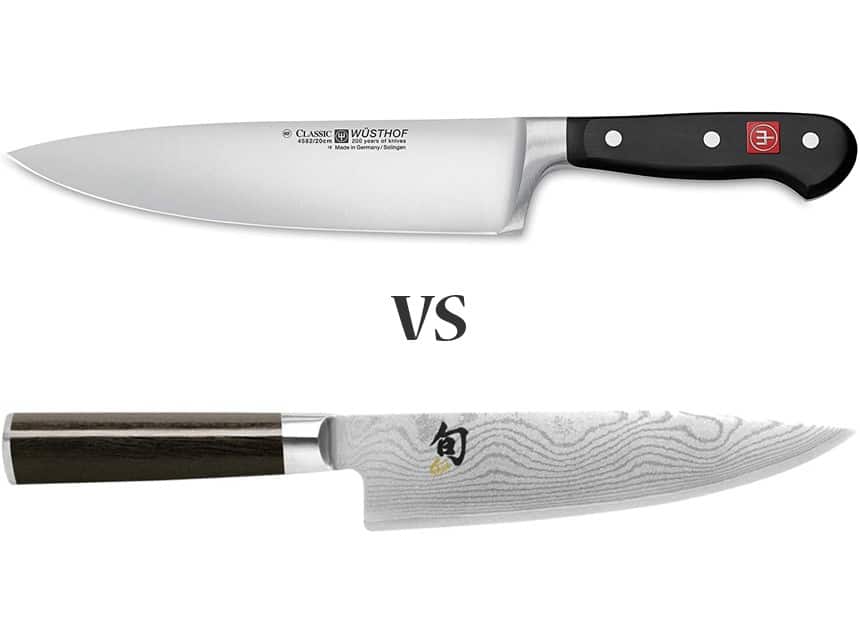
When you’re buying a kitchen knife, especially if you’re investing in a quality one, it’s worth considering exactly what you want from the knife.
Some brands focus on sharpness, some comfort and some on durability..
Two great brands people are often deciding between are Mac and Messermeister. They both produce quality knives, which then begs the question, which one should you buy?
In this article, I’m going to tell you the differences between these two great brands. I’ll go in-depth into the details of each, talking about where they are made, what materials are used and the difference in price.
This article should provide all the information you need to select the right knife for your needs.
Mac knives offer a far superior, sharper cutting edge; however, Messermesiter knives are much more durable, making them well suited to busy family kitchens.
| My recommendation | Current price |
| Mac Professional 8-Inch | View on Amazon (opens new tab) |
| Messermeister Oliva Elite 8-Inch | View on Amazon (opens new tab) |
Mac vs Messermeister – Comparison Table
Here is my summary comparison table for each brand. This is mostly based on their main range of knives; the Mac Professional and the Messermeister Meridian Elite.
For a more in-depth look at each category then check out the rest of the article below.
| Category | Mac | Messermeister |
| Country of Manufacture | Japan | Germany |
| Steel type | VG-5 | X50CrMoV15 (1.4116) |
| Rockwell hardness | HRC 59-61 | HRC 57 |
| Factory edge | ~15 degrees (double bevel) | 15 degrees (double bevel) |
| Handle material | Pakkawood (wood/resin composite) | POM (thermoplastic) |
| Price range | $160 – $180 (Professional) | $150 – $170 (Meridian Elite) |
| Main benefit | Sharper with better edge retention | More durable |
| My recommendation | 8-Inch Professional (view on Amazon) | Messermeister 8-Inch Meridian Elite (view on Amazon) |
Mac vs Messermeister – Where are they made
| Brand | Country of manufacture |
| Mac | Japan |
| Messermeister | Germany |
All Mac knives are manufactured in the Japanese city of Seki. Seki is known as the knife capital of Japan, with a population of only 90,000 it lies around 150 miles from Toyoko but is the central hub for all of Japan’s major knife manufacturers.
Mac has been making knives since 1964, selling over 25 million of their fantastically designed East-meets-West knives.
Messermeister Knives are also produced in the German city of Solingen, where they have been produced since their launch in 1985.
Messermeister is German for Knife (Messer) Maser (Meister), they have always had a focus on innovative design whilst still being influenced by German classics.
Bernd Dressler, the founder of Messermeister was the first western knife maker to introduce a bolsterless heel to his knife range, a trend that is found throughout western knives today.
Both of these brands produce their knives in the homeland of their heritage, an added bonus for anyone looking for a genuine German or Japanese knife.
Mac vs Messermeister – What steel do they use
The steel used in knives will often change depending on which range you pick.
Here I’m going to focus on the most popular range for both Mac and Messermeister knives.
They actually use the same steel, there is just a slight variation in hardness, most likely due to the way the steel is treated during manufacture.
| Brand | Steel type | Rockwell hardness |
| Mac Professional | VG-5 | HRC 59-61 |
| Messermeister Meridian Elite | X50CrMoV15 (1.4116) | HRC 57 |
The Mac Professional range uses the Japanese steel VG-5. All Mac knives are made from some version of the Takefu V-Gold (VG) steel varieties.
It’s a very hard steel, which allows for a very sharp cutting edge.
We can see why when we look at VG-5’s levels of Carbon, Vanadium and Chromium.
The Carbon level is much higher at around 0.75%. That makes the blade harder, allowing for a finer edge, but it also makes it more brittle and prone to chipping.
The Chromium content is high at around 14%, it’s not super high but it still makes this a quality stainless steel that will be very resistant to rust.
Messermeister uses X50CrMoV15. This is a German steel that is used for the majority of Messermeister knives.
It’s popular steel amongst producers of quality western-style knives. That’s because it has a particular focus on durability, whilst retaining enough strength for a sharp edge.
The main elements of interest within X50CrMoV15’s composition are Carbon, Vanadium and Chromium.
The Carbon content is 0.55%. That’s not particularly high when comparing it with other quality knives; however, it’s high enough to provide sufficient strength in the blade for a 15 – 20 degree angle on each side, which is standard for western knives.
The big benefit of not having a very high Carbon content is that higher Carbon steels are usually more brittle, therefore the 0.55% content keeps the blade durable.
That’s the same with the strong Vanadium of 0.4%, Vanadium improves the resistance to wear of the steel also adding to its durability.
The Chromium content is 15% is what the 15 in X50CrMoV15 represents. Chromium is vital for the durability of steel as it’s what makes stainless steel resistant to rust.
Steel need only be 10.5% to be considered stainless, so a 15% content is high and makes this a quality stainless steel, very unlikely to rust unless extremely mistreated by the owner.
Overall the main difference between the Mac’s VG-5 steel and Messermeister’s X50CrMoV15 steel is that X50CrMoV15 has been made with a very strong focus on durability, whereas VG-5 is focused on hardness, allowing for a finer edge.
This is reflected in their comparative Rockwell Hardness (HRC). The Mac Professional knives have a much higher HRC than Messermeister and thus the steel is a lot harder and able to hold a sharper edge.
Mac vs Messermeister – How sharp are they
Once again I’m going to focus on the most popular knives from each brand for this comparison.
You will experience a far sharper edge using Mac knives than Messermeister knives due to the steel of the Mac knives being much harder.
| Brand | Factory edge | Rockwell hardness |
| Mac Professional | ~15 degrees (off center double bevel) | HRC 59-61 |
| Messermeister Meridian Elite | 15 degrees (double bevel) | HRC 57 |
Sharpness is vital when looking for a knife, but in this case, there’s a bit more to it than just looking at which knife has the smallest angle of its edge.
Usually, the smaller the angle the sharper the blade. However, there are other considerations that are particularly important when comparing these two knives.
Harder knives will hold a sharper edge for longer. The Mac uses much harder steel than the Messermeister.
Mac uses Japanese steel and that tends to have a focus on hardness, in order to create a sharper edge.
So, even though Messermeister knives are made with a similar factory edge of 15 degrees, the Mac knife will actually hold its edge for much longer.
Mac also design the edge of their knife in an unusual way.
Whereas Messermeister knives use a standard bevel edge, with each side of the knife slanting at the same 14-degree angle to form a point, Mac knives have an off-center angle to the edge.
That means that one side of the knife has a smaller angle than the other, a technique that results in a sharper blade.
It’s a mix between the Japanese style of a single bevel edge, which are incredibly sharp, and a western double bevel edge.
The combination of this edge design and the hard steel means that you will experience a sharper edge using Mac knives.
Mac vs Messermeister – What are the handles made from
The material used for handles is a vital and often overlooked feature of any knife.
A quality handle is often the sign of a quality overall knife. Handles need to be made from a durable material that can withstand all the heat and moisture fluctuations knives can experience in the kitchen.
Once again we’ll focus on the two main ranges from each brand, the Mac Professional and Messermeister Meridian Elite.
| Brand | Handle material |
| Mac Professional | Pakkawood (wood/resin composite) |
| Messermeister Meridian Elite | POM (thermoplastic) – Although other Messermeister ranges use stunning timber for the handle |
Mac use a wood/resin composite called Pakkawood for their knife handles.
Pakkawood is extremely common in knife handles for quality Japanese knives, although many non-Japanese knife manufacturers around the world have begun to use it as well.
Pakkawood is a great material for knife handles, it’s more dense and durable than real timber. That means it’s more resistant to wear and tear and won’t crack over time as timber handles might.
The versatility of design also makes it a popular choice, it can be dyed all sorts of colors and will often give the appearance of a true wood finish.
Pakkawood is very resilient to temperature and moisture changes and makes a terrific material of choice, it also adds to the Japanese influence of the knife with Pakkawood being a popular Japanese knife handle material.
Messermeister use a thermoplastic material called POM (Polyoxymethylene) for their Meridian Elite knife handles.
Although, it is worth mentioning that Messermeister use some very attractive timbers for their other ranges such as Royale Elite (American Walnut) and Oliva Elite (Olive Wood) that are exquisitely beautiful.
But for now, let’s focus on POM as that is used by their main range. Materials like these are ideal for knife handles due to their extreme durability.
POM is specifically designed for high stiffness and stability, and being a thermoplastic means it’s also extremely resistant to temperature and moisture changes.
It’s a fantastic material to use for knife handles, that will undergo all sorts of pressures and it makes sense to use this material for your main range, which is usually your more practical range.
However, as I’ve mentioned above, Messermeister in particular has some stunning handles in their other collections. I particularly like the Olive Wood handle used in their Oliva Elite collection.
So, although their main range uses the same handle material, I’d say the exquisite timber used by Messermeister.
I’ll link to the Messermeister Oliva Elite Chef’s knife at the bottom of this article, it’s well worth a look.
Mac vs Messermeister – How much do they cost
Both these brands have wide ranges of knives all at differing price ranges.
To allow for a fairer comparison I’ve categorized three of their major ranges that represent their highest and lowest cost knives.
I’ve tried to compare similar knives, sticking to 8 Inch Chef’s knives or the closest equivalent they have in the range.
In brackets next to the general price range you’ll see the name of the range.
These prices are rough estimates. Prices do change over time but this is intended as a rough guide.
| Brand range | Mac | Messermeister |
| Premium | > $200 (Ultimate) | $170 – $190 (Oliva Elite) |
| Standard | $160 – $180 (Professional) | $150 – $170 (Meridian Elite) |
| Value | $80 – $100 (Chef’s Series) | $35 – $45 (Four Seasons) |
It’s pretty clear that both Mac and Messermeister offer a quite similar range of prices for their knives, with Mac knives being slightly more expensive.
Messermeister has a slightly lower price for their more value range but the mid range Professional and Meridian Elite are very similar.
So I would say that which one you pick should be strongly based on your budget, it should be based on what the differences are and what’s more important to your needs.
Let’s look at that next.
Mac vs Messermeister – What is the difference
Now that we have looked at the design, materials, background and price of these brands we can fully understand the difference, and you should be able to make an informed decision on which knife is correct for you.
The main difference between Mac and Messermeister knives is the sharpness and durability, created from the steel used and the design of the edge.
| Brand | Main benefits |
| Mac | Sharper with better edge retention |
| Messermeister | More durable |
The Mac is by far the sharper blade and that’s mainly what you’re paying the higher price for.
It’s a clever mix between a Japanese single bevel and a Western double bevel makes it sharper out of the factory, and the Japanese steel used, with its 0.75% Carbon content, means it will hold its sharp edge for significantly longer than a Messermeister knife.
However, with its higher Carbon content and lower Vanadium content in comparison with the Messermeister, the Mac will also be more brittle and prone to chipping.
That’s fine if you are able to take care of the knife, it won’t chip very easily.
Whilst the Messermeister’s steel can’t compete with the Mac on sharpness, it is the more durable of the two. It’s more rust resistant and less like to chip along the blade.
That’s important if you don’t want to worry too much about maintaining your knife.
With that understood, it should now be easy to choose between the two knives.
Mac vs Messermeister – Which is better for you
This is down to what you want from your kitchen knives.
For someone looking for an extremely sharp blade, the Mac is the obvious choice. For anyone interested in Japanese influenced knives, who will be able to care for the knife properly, I would recommend the Mac all day long.
Caring for a Mac is not exactly hard, all you need to do is store it individually, such as in a knife block, using a blade sheath, or on a magnetic strip.
Essentially, you want to avoid knocking the blade edge against other hard objects when you’re not using it.
In busy family kitchens, where knives are likely to be thrown into the kitchen sink, cutlery drawer, or dishwasher without a second thought, this can be difficult.
But you’re aware of how to look after the blade, and just ensure it is properly stored after use, then the Mac will provide a superior cutting edge.
For a busy family kitchen, where multiple people might be using the knife or it’s a risk of being damaged or left soaking in water, then I would recommend the Messermeister.
It’s more durable than the Mac and will require less care and attention.
The blade is still plenty sharp enough for a western knife and if you just want a reliable knife for really good value then the Messermeister is the knife for you.
My Mac Recommendation

View the 8-Inch Professional Mac on Amazon (opens new tab)
For my Mac recommendation, I’m also going to the mid-range priced Professional Chef’s knife.
It uses hard steel and unique blade design, allowing for a sharper edge.
The side of the knife is also dimpled, which reduces the surface area and thus stops food from sticking to the blade, another clever design touch.
The materials used are all premium quality and for a Japanese knife with a large Carbon content it is actually very durable and at 14% Chromium is a good quality stainless steel too.
Some high-Carbon Japanese knives contain almost no Chromium at all and can begin to rust overnight if left wet, this Mac is a far cry from those.
When it comes to Japanese blades this Mac is a great balance between amazing sharpness and durability.
My Messermeister Recommendation

View the 8-Inch Messermeister Oliva Elite on Amazon (opens new tab)
For my Messermeister recommendation I’ve gone with one from their premium collection, especially the Oliva Elite collection.
This knife is stunning. I think it’s the most attractive western style Chef’s knife available and it’s the designs of their premium collections that is the main differing factor between Messermeister and Wüsthof knives.
It uses the same steel as the Wüsthof, so it’s still ulta-durable, but the Olive Wood handle gives it such a beautiful finish that it really stands out from other knives.
Olive wood won’t be quite as durable as the POM thermoplastic used on the main collections for both Messermeister and Wüsthof, so you will have to avoid doing things like soaking it in the kitchen sink, because that’s clearly going to warp the wood over time.
But as timber goes, Olive wood is still a good material for knife handles, it’s hard and strong so it will be durable, it’s just hard to match the artificially created durability of substances like POM with natural materials.
It’s a great knife, so if you want to add a bit of beauty to your kitchen then there are few better choices than this Messermeister Oliva Elite.

